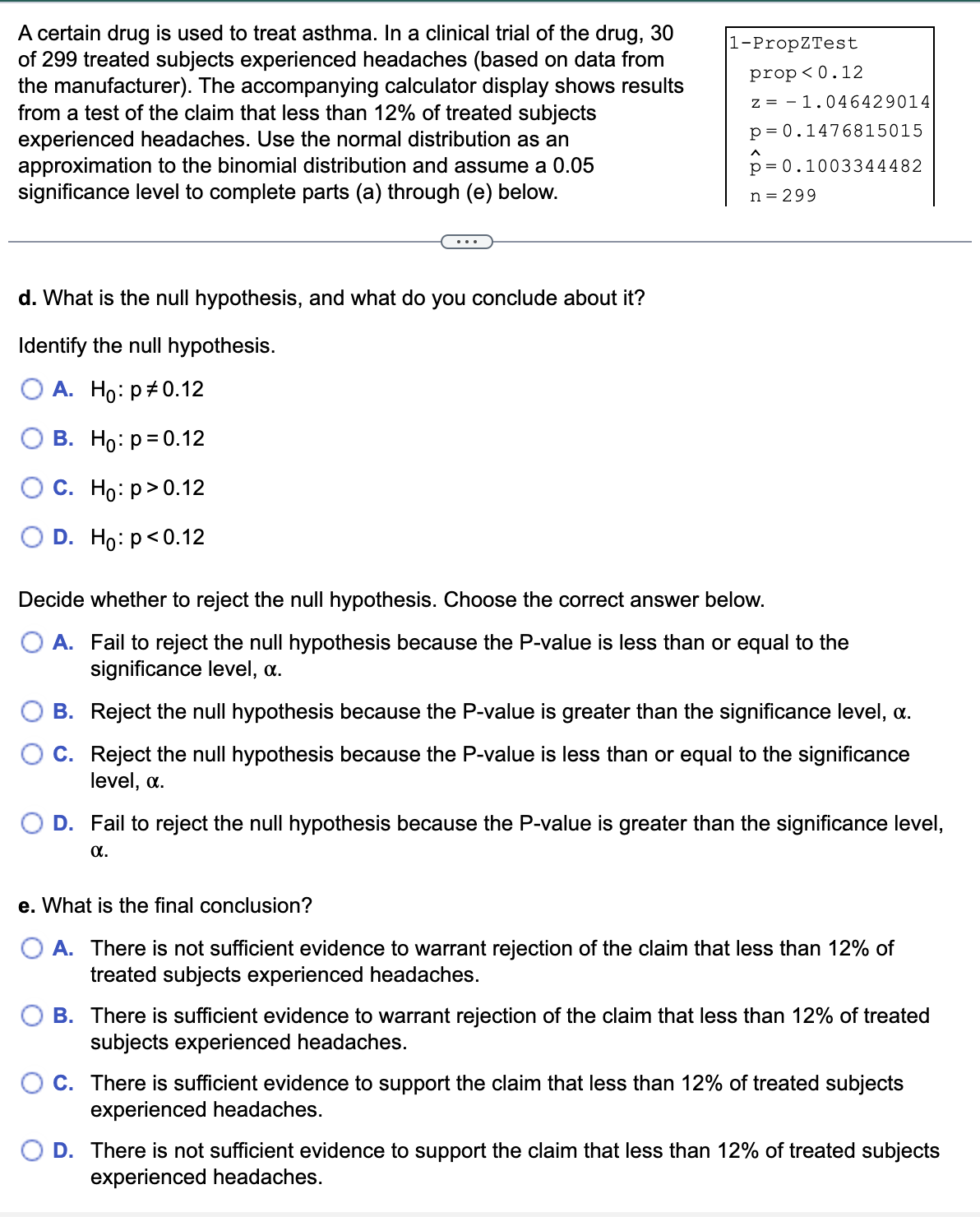d. What is the null hypothesis, and what do you conclude about it? Identify the null hypothesis. A. Ho: p = 0.12 B. Ho: p=0.12 OC. Ho: p>0.12 D. Ho: p<0.12 Decide whether to reject the null hypothesis. Choose the correct answer below. A. Fail to reject the null hypothesis because the P-value is less than or equal to the significance level, a. B. Reject the null hypothesis because the P-value is greater than the significance level, a. C. Reject the null hypothesis because the P-value is less than or equal to the significance level, a. D. Fail to reject the null hypothesis because the P-value is greater than the significance level, α. e. What is the final conclusion?
d. What is the null hypothesis, and what do you conclude about it? Identify the null hypothesis. A. Ho: p = 0.12 B. Ho: p=0.12 OC. Ho: p>0.12 D. Ho: p<0.12 Decide whether to reject the null hypothesis. Choose the correct answer below. A. Fail to reject the null hypothesis because the P-value is less than or equal to the significance level, a. B. Reject the null hypothesis because the P-value is greater than the significance level, a. C. Reject the null hypothesis because the P-value is less than or equal to the significance level, a. D. Fail to reject the null hypothesis because the P-value is greater than the significance level, α. e. What is the final conclusion?
MATLAB: An Introduction with Applications
6th Edition
ISBN:9781119256830
Author:Amos Gilat
Publisher:Amos Gilat
Chapter1: Starting With Matlab
Section: Chapter Questions
Problem 1P
Related questions
Question

Transcribed Image Text:A certain drug is used to treat asthma. In a clinical trial of the drug, 30
of 299 treated subjects experienced headaches (based on data from
the manufacturer). The accompanying calculator display shows results
from a test of the claim that less than 12% of treated subjects
experienced headaches. Use the normal distribution as an
approximation to the binomial distribution and assume a 0.05
significance level to complete parts (a) through (e) below.
d. What is the null hypothesis, and what do you conclude about it?
Identify the null hypothesis.
O A. Ho: p0.12
B. Ho: p=0.12
C. Ho: p>0.12
D. Ho: p<0.12
1-PropZTest
prop<0.12
z
1.046429014
p= 0.1476815015
p=0.1003344482
n = 299
Decide whether to reject the null hypothesis. Choose the correct answer below.
O A. Fail to reject the null hypothesis because the P-value is less than or equal to the
significance level, a.
B.
Reject the null hypothesis because the P-value is greater than the significance level, a.
C. Reject the null hypothesis because the P-value is less than or equal to the significance
level, a.
D. Fail to reject the null hypothesis because the P-value is greater than the significance level,
α.
e. What is the final conclusion?
A. There is not sufficient evidence to warrant rejection of the claim that less than 12% of
treated subjects experienced headaches.
B. There is sufficient evidence to warrant rejection of the claim that less than 12% of treated
subjects experienced headaches.
C. There is sufficient evidence to support the claim that less than 12% of treated subjects
experienced headaches.
D. There is not sufficient evidence to support the claim that less than 12% of treated subjects
experienced headaches.
Expert Solution
This question has been solved!
Explore an expertly crafted, step-by-step solution for a thorough understanding of key concepts.
Step by step
Solved in 4 steps

Recommended textbooks for you

MATLAB: An Introduction with Applications
Statistics
ISBN:
9781119256830
Author:
Amos Gilat
Publisher:
John Wiley & Sons Inc

Probability and Statistics for Engineering and th…
Statistics
ISBN:
9781305251809
Author:
Jay L. Devore
Publisher:
Cengage Learning

Statistics for The Behavioral Sciences (MindTap C…
Statistics
ISBN:
9781305504912
Author:
Frederick J Gravetter, Larry B. Wallnau
Publisher:
Cengage Learning

MATLAB: An Introduction with Applications
Statistics
ISBN:
9781119256830
Author:
Amos Gilat
Publisher:
John Wiley & Sons Inc

Probability and Statistics for Engineering and th…
Statistics
ISBN:
9781305251809
Author:
Jay L. Devore
Publisher:
Cengage Learning

Statistics for The Behavioral Sciences (MindTap C…
Statistics
ISBN:
9781305504912
Author:
Frederick J Gravetter, Larry B. Wallnau
Publisher:
Cengage Learning

Elementary Statistics: Picturing the World (7th E…
Statistics
ISBN:
9780134683416
Author:
Ron Larson, Betsy Farber
Publisher:
PEARSON

The Basic Practice of Statistics
Statistics
ISBN:
9781319042578
Author:
David S. Moore, William I. Notz, Michael A. Fligner
Publisher:
W. H. Freeman

Introduction to the Practice of Statistics
Statistics
ISBN:
9781319013387
Author:
David S. Moore, George P. McCabe, Bruce A. Craig
Publisher:
W. H. Freeman